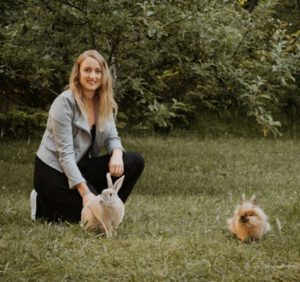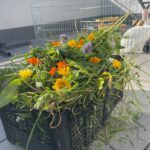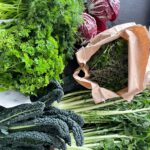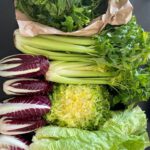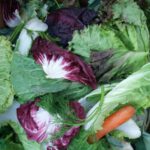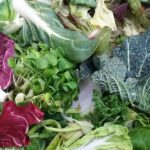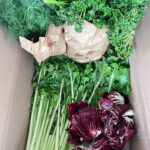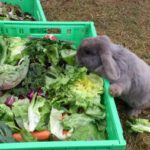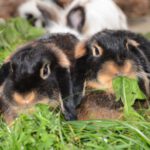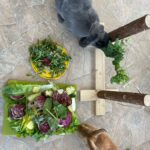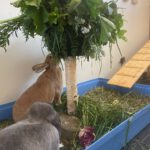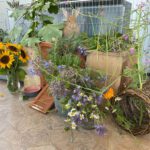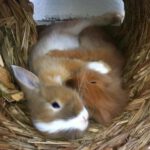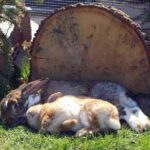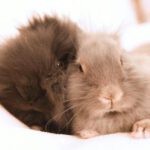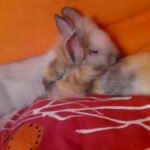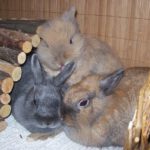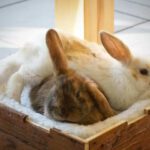The biggest myths in feeding rabbits
‚It is easier to split an atom than to overturn a prejudice‘
Albert Einstein
Contents
- 1. ‚Rabbits should receive 100g of vegetables per kg of body weight‘ (100g-rule)
- 2. ‚Pet rabbits cannot eat fresh food as it may lead to digestive problems‘
- 3. ‚The basic diet of rabbits is hay‘
- 4. ‚Rabbits need to feed constantly‘
- 5. ‚In the past dry food was fed, today the diet is free of dried foods‘
- 6. ‚Herbs have medical effects and hence should only be fed rarely. First, they can have side effects in the healthy rabbit and second, they wouldn’t have any health benefit in case of illness.‘
- 7. ‚Herbs/carrot green etc contain too much Calcium and hence, shouldn’t be fed too much‘
- 8. ‚Rabbits should eat a lot of hay. If they don’t, something is wrong and they should be forced to eat more.‘
- 9. ‚Rabbits can’t select poisonous plants.‘
- 10. ‚Forage crops with many essential oils are less suitable as food.‘
- 11. ‚None of the cabbage varieties and clover should be fed, as they cause bloating in the rabbit.‘
- 12. ‚A lot of fresh food causes an overload of the stomach and other digestive problems.‘
- 13. ‚Hay is of equal quality than fresh meadow grass‘
- 14. ‚Rabbits suffering from diarrhoea should be solely fed on a hay diet.‘
- 15. ‚Pet rabbits are domesticated and hence not able to select any more.‘
- 16. ‚A rabbit that doesn’t drink is ill.‘
- 17. ‚If a rabbit is fed ad libitum, food is more prone to rot.‘
- 18. ‚Rabbits start suffering from diarrhoea if fed too much fresh or green fodder.‘
- 19. ‚Industrial dry food is ideally adapted to the needs of a rabbit.‘
- 20. ‚Dry food only guarantees an optimal supply of all nutrients!‘
- 21. ‚Dry food (like pellets) is necessary and important for dental abrasion‘
- 22. ‚Rabbits‘ teeth are worn down from hard food.‘
- 23. ‚Chewing of bread helps to wear down the teeth.‘
- 24. ‚Rough, long hay is important for wearing down teeth; hence, rabbits should eat a lot of hay.‘
- 25. ‚Bulbous plants and potatoes are poisonous.‘
- 26. ‚Rabbits can’t select; if unlimited fresh food is available they’ll become obese.‘
- 27. ‚Grainfree food is a healthy replacement for mixed feed.‘
- 28. ‚Cereals are poisonous for a rabbit.‘
- 29. ‚Salad, cucumber, etc. are inferior as they hardly contain any nutrients and only a lot of water.‘
- 30. ‚Pellets consist of pressed herbs.‘
- 31. ‚A rabbit’s diet should consist of 80% hay and 20% fresh food.‘
- 32. ‚Fruit and vegetables need to be washed with hot water.‘
- 33. ‚It is recommended to peel fruit and vegetables when fed to rabbits.‘
- 34. ‚If caecum droppings are found, a rabbit is ill.‘
- 36. ‚Apple pips are poisonous and should be removed before apples are fed to a rabbit.‘
- 37. ‚Stone fruit twigs contain hydrocyanic acid and hence shouldn’t be fed.‘
- 18. ‚The gastro intestinal tract of a rabbit isn’t similar to its wild relative, as our pet rabbits are domesticated.‘
- 39. ‚Fruit (e.g. apples) contain a lot of sugar and hence shouldn’t be fed more often than 2-3 times per week.‘
- 43. ‚Eating of twigs and chewing on wood or other hard objects wears off the teeth.‘
- 44. ‚Rabbits have a ’stuffed‘ stomach and ’stuffed‘ intestines.‘
- 45. ‚I’m worried to poison my rabbits. That’s why I don’t feed any fresh herbaceous plants, but only hay and vegetables.‘
- 46. ‚Hay crumbles at the bottom of the bag are dangerous for rabbits.‘
- 47. ‚Chocolate is poisonous for a rabbit.‘
- 48. ‚Root vegetable make rabbits fat and are extremely high in calories.‘
- 29. ‚(Root) vegetables are high in carbs (sugar, starch), which unbalance the intestinal flora! Hence, rabbits should be fed with hay and meadow herbs and not with larger amounts of vegetables.‘
- 51. ‚There’s only one correct type of diet for rabbits. This has to be adhered to!‘
- 52. ‚Wild rabbits mainly eat hay in winter and no fresh food.‘
- 53. ‚Don’t pick from meadows that are known to be frequented by dogs (transmission of diseases through dog poo).‘
- 54. ‚Only rabbits that are kept outside – if at all, may have to put on some weight in winter. If rabbits are kept indoors this weight gain should be counteracted!‘
- 56. ‚Rabbits that haven’t been kept well, that have been kept indoors or that didn’t grow up with meadow food are not able to select.‘
- 57. ‚Silage is an unsuitable food for rabbits and may even be harmful.‘
- 58. ‚Variances in weight indicate illnesses. Through regular meassurements of the rabbits‘ weight illnesses can be identified timely.‘
- 59. ‚Artificial vitamins are harmless and play an important role in the nutrition of a rabbit.‘
1. ‚Rabbits should receive 100g of vegetables per kg of body weight‘ (100g-rule)
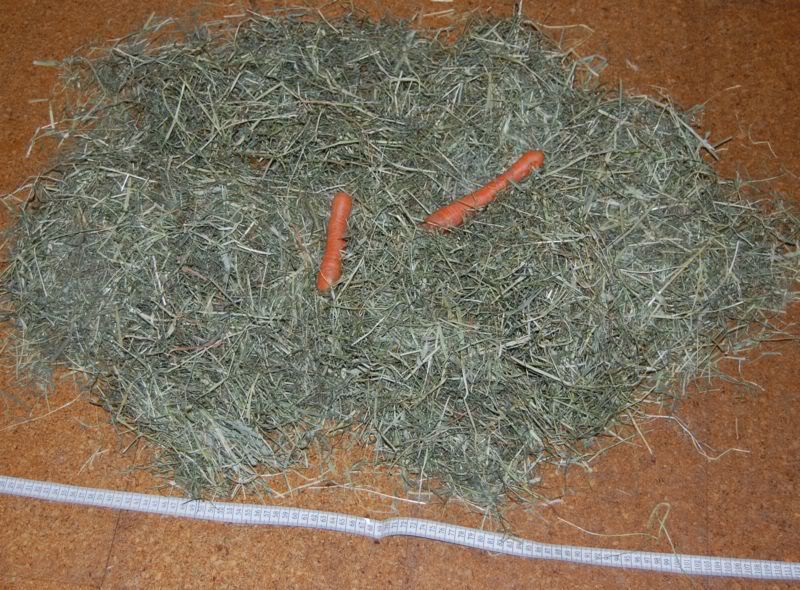
This rule has been developed many years ago in the internet as a rule of thumb and in order to determine the required amount of fresh food. However, this wasn’t about determining the ideal amount of food but rather the necessary amount to survive. In a time where people complemented hay and dried food with a little bit of vegetables, this rule helped to realise that a certain amount of fresh food is vital for rabbits.
Unfortunately this rule stayed unchallenged and even years later has been put into a complete wrong context and been referred to as the ideal amount of food.
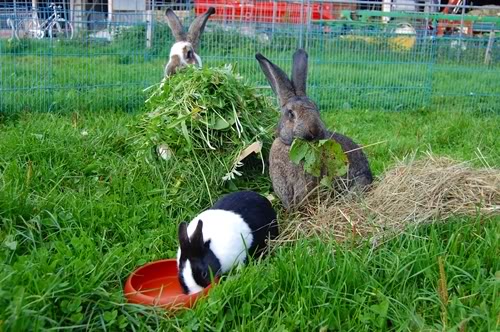
In nature wild rabbits eat almost solely fresh food, hence is the amount to survive in everyday life not sufficient to provide them with a balanced diet overall. It is recommended to always provide as much herbage to be enough until the next feed and to complement this with raw fruit vegetables, root vegetables and only a little bit of fruit. Herbage as well as hay should be provided throughout day and night.
It is said the internet never forgets anything – however, it is rather less the internet than the circle of pet owners, who spread this rule and stuck onto without it being challenged once. Presumably it is easier to pass a rule on than to step deeper into this topic. Our own experience has shown that this is the case when pet owners repetitively ask for clear rules and feeding plans. These give owners reassurance that the diet they are offering their rabbits is the correct one.
* Note: Meanwhile, the rule has been re-written: ‚Basically, provide always so much food that it never runs empty! As a rough rule of thumb: ~80g fresh food requires a 1kg rabbit in winter with a little herbage to survive (thus that enough vitamins and other nutrients are provided and no signs of malnutrition occur). The actually required amount of vegetables is dependent on the quality and variety of the amount of fresh food and the requirements of the individual animal. […] Basically rabbits are allowed to eat as much vegetables as they like…‘
2. ‚Pet rabbits cannot eat fresh food as it may lead to digestive problems‘

It doesn’t make a difference whether a rabbit eats fresh food or ‘dry’ fresh food and drinks water: both water and fresh food arrive in the digestive system. Both are completely unproblematic as long as the rabbit is used to fresh food. Wild rabbits will feed on wet food on rainy days too without any problems.
Many breeders and pet rabbit owners feed wet fresh food without ever experiencing problems; this is supported by scientific feeding trials. But how did this rumour develop that pet rabbits cannot eat wet fresh food?
Fresh food, when not stored and handled well, may lead to fermentation. This happens when fresh food is washed but not properly dried before storing. Rabbits cannot digest fermented fresh food. Thus, special attention has to be paid when handling fresh food. It shouldn’t be pressed and packed in a plastic immediately without drying the wet fresh food. Sounds like preparing fresh food for the pet owners? Indeed, and with tender loving care.
3. ‚The basic diet of rabbits is hay‘

Wild rabbits are folivores: they feed on a varied choice of wild herbs, leaves, roots and young grasses. Our pet rabbits still possess an almost identical gastro-intestinal tract and the same requirements for food. Rabbits‘ basic food hence consists of meadow herbs and grasses. Hay however is grass that has been dried (and may contain a few dried herbs too). The drying process naturally results not only in a loss of water but also in a loss of vitamins and minerals. Therefore hay hasn’t got the same quality as fresh food; it is merely a non perfect replacement in the basic diet of our rabbits.
See: The gap between lack and abundance of food: the secret of a needs based nutrition
4. ‚Rabbits need to feed constantly‘
Studies have shown that adult rabbits take about 30 meals a day. Thus they don’t feed constantly but rather in many small portions. We therefore cannot speak of continuous feeding. However it is correct to say: ‚Rabbits require a varied offer of food around the clock and feed throughout the day multiple smaller portions. The main proportion of food is thereby eaten at dusk and dawn‘.
5. ‚In the past dry food was fed, today the diet is free of dried foods‘
Depending when ‚in the past‘ starts this statement is more or less wrong. Dried Food for rabbits have only been on the German market since 1953. Before this, rabbits haven’t been fed with industrially produced foods. Only since then the diet of a rabbit started to contain more and more industrially produced food. These days an opposite trend can be noticed as the disadvantages and effects of these have been made public.
6. ‚Herbs have medical effects and hence should only be fed rarely. First, they can have side effects in the healthy rabbit and second, they wouldn’t have any health benefit in case of illness.‘
The natural basic diet of rabbits consists of herbs and rabbits are adapted to a herb rich diet. The above statement may rather refer to humans who are omnivores. The human nutrition can’t be compared to the nutrition of a rabbit. An animal, whose main food consists of herbs, hasn’t got any problems with the utilisation of this type of plant.
That herbs, if fed regularly, don’t have an effect anymore in cases of illness is incorrect. On the contrary: if consumed regularly illnesses may be prevented. For herbs to develop their full medical effect, special methods for storing, drying and other specific methods are applied (e.g. compresses, infusions, etc.).
Packed herbs from a pet shop are therefore less effective. However, rabbits are capable by selecting carefully the right herbs in the right quantities to achieve the necessary medical effect and to exclude any unwanted side effects. See also: Self medication and Selection
7. ‚Herbs/carrot green etc contain too much Calcium and hence, shouldn’t be fed too much‘
As the basic diet of our rabbits consists of herbs it is needless to say that statements about their basic diet not being ideal are dangerous to voice. Rabbits are very specialised on the intake and metabolism of herbs.
Nevertheless, see this justification for the calcium problem:
Calcium is an essential mineral that the body has to obtain through food. Usually, even excesses of calcium aren’t a problem as the natural nutrition of a rabbit is high in water (herbs consist of ~80% water). Therefore calcium is well diluted in the body and excreted without problems. However, if the water content of the diet is low (e.g. rabbit is fed with concentrated food – hay is only a concentrate), calcium may accumulate in the organs (especially in the kidney and bladder). Due to a lack of water a calcium mush is formed, that is easily deposited in the body. If more water is available calcium won’t concentrate to an extend where it would be deposited; the water dilutes the calcium and flushes it off the body (a lot of water facilitates excess calcium being flushed from the body) and plaques can’t be deposited. Thus, the trigger of the many bladder and kidney infections isn’t the calcium in itself but rather a diet rich in dry food – and this isn’t natural.
A diet adapted to the requirement of the species and therefore rich in fresh foods can’t pose a problem with calcium. Calcium only becomes problematic if rabbits live on a diet rich in concentrates and especially if these concentrates have a high calclium content (dry food, hay…). Incidentally, dried herbs show on average a less high or similar calcium content than hay.
8. ‚Rabbits should eat a lot of hay. If they don’t, something is wrong and they should be forced to eat more.‘
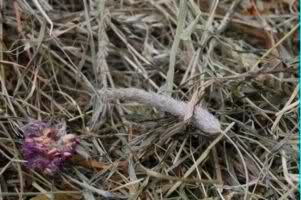
Rabbits often prefer fresh foods over hay and hence owners are often worried as their rabbit doesn’t eat a lot of hay. However, rabbits know what they need and thus prefer fresh food. Hay is only a replacement for fresh meadow plants (the natural basic diet of a rabbit). The water content is much lower and it also contains fewer vitamins than fresh food and is consequently a detrimental food. It’s not a problem if rabbits hardly eat any hay as long as they get many grasses, herbs, leafy vegetables, etc. This is even much healthier than a diet rich in hay.
A diet rich in meadow greens and other leafy food may automatically result in the low intake of hay and the rabbit will rather choose the healthier food (fresh food).
9. ‚Rabbits can’t select poisonous plants.‘
A most persistent myth of which many rabbit owners are understandably scared off is to poison their rabbits. However, rabbits select by using their senses (taste, smell…) and are thus able to identify poisonous plants. Poisonous plants produce their poisons to keep natural enemies away so they are not eaten. Rabbits take a ‚taste bite‘ to find out about the plant. It goes even further: Rabbits are able to make use of the poison by deliberately choosing poisonous plants when they are ill. These substances are often also used in the pharmaceutical industry in the manufacture of medicines.
You’ll find more comprehensive information here: ‚Selection of poisonous plants‘
Besides: Animals are these days used in scientific studies to identify variations in food items. Laboratory experiments have shown that animals favour organic vegetables over conventionally grown vegetables – by contrast, humans haven’t been able to identify these variations not even with the most modern testing methods!
However: the ability to select still has its limit! Highly poisonous plants shouldn’t be offered. The ability to select is made more difficult if the conditions in which animals are kept are less satisfactory and their food deficiant.
10. ‚Forage crops with many essential oils are less suitable as food.‘
Essential oils are diverse and so are their effects. Fennel, for example, contains many essential oils which are relaxing and have a regulative effect on the digestive system. Essential oils belong to the bioactive substances; an inadequate supply of bioactive substances may cause many illnesses. Scientific human studies have concluded that bioactive substances have a beneficial effect on health.
Essential oils are considered to be responsible for the healing properties of plants and are said to protect that plant from enemies, bacteria, viruses and fungi. Secondary plant substances have carcinogenous, antimicrobial, antiviral, antispasmodic, expectorant, antithrombotic, immunomodulatory, relaxing, stimulating and antiinflammatory effects. They play a role in lowering cholesterol levels and have a positive effect on the blood sugar and blood pressure.
Essential oils primarily contain monoterpene derivatives, which show positive health effects on many illnesses (in particular respiratory diseases and disorders of the digestion). Concentrated essential oils, however, may have a negative health effect (irritation of the mucous membranes, trigger of allergies). If essential oils are however supplied by plants of which our rabbits can choose from and as part of a varied diet, the health effects are only positive. The plants which wild rabbits select often contain many essential oils and consequently play a rather important role as a constituent of a rabbit’s diet.
11. ‚None of the cabbage varieties and clover should be fed, as they cause bloating in the rabbit.‘
Myth Cabbage:
The myth that cabbage shouldn’t be fed originates in times when rabbits where fed primarily with compound feed. This type of diet puts a heavy strain on the digestive system and causes poor digestion so that intolerances are likely to develop. Such a ’sick‘ digestive system can naturally only cope with little or maybe even no cabbage at all. However, this doesn’t apply only to cabbage, many other fresh foods, even such as dandilions and grass may hardly be tolerated or even not at all if rabbits are fed with industrially produced dry food from the pet shops.
Healthy rabbits tolerate cabbage similarly to other fresh food.
Still, cabbage should generally only be fed in a good mixture of varied fresh foods. However, healthy rabbits will digest cabbage very well even if cabbage was the sole source of food. Cabbage is a very important part of a rabbit’s diet in winter, something that should never be sacrified. This is equally applicable for clover and alfalfa.
12. ‚A lot of fresh food causes an overload of the stomach and other digestive problems.‘
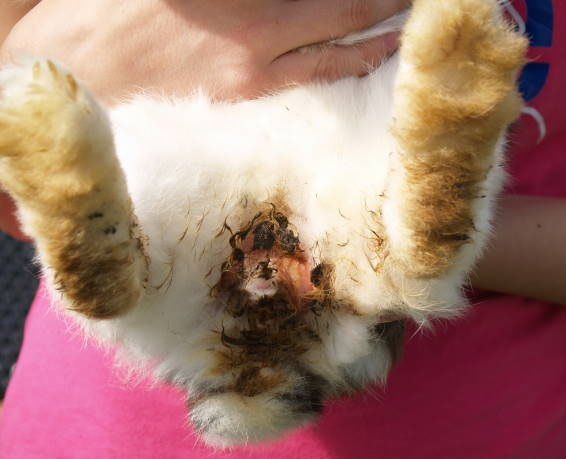
On average rabbits feed on 30 portions of food a day. If feeding is rationalised a rabbit is forced to take two main meals and is hence far away from the naturally ’30 meals‘ a day.
Wild rabbits are surrounded 24/7 by a huge variety of food – hundreds of herbs, grasses and other plants. Thus, rabbits are able to ration their food as they wish.
What is the effect of unrestricted access to fresh food on the gastrointestinal tract and the feeding behaviour?
A rabbit that is fed on rationalised food gobbles down the food provided, as it is used to the fact that for the rest of the day it may only be left with hay and no other species typical food (e.g. fresh meadow herbs). Furthermore it consumes it main meals only at the times when it’s provided with fresh food. Whereas, if it’s provided with a large variety of food throughout the day (and night), it can comfortably have meals whenever it wants and with no need to gobble it down – like a wild rabbit in its natural habitat. Hence, feeding rabbits ad libitum is gentle and supportive for the digestive system, as it doesn’t interfer with their natural habits to feed. Consequently an overloaded stomach is most likely to occur, when rabbits ravenously gobble down the little portion of fresh food they are provided with, as it is aware that afterwards their only source of food is hay.
13. ‚Hay is of equal quality than fresh meadow grass‘
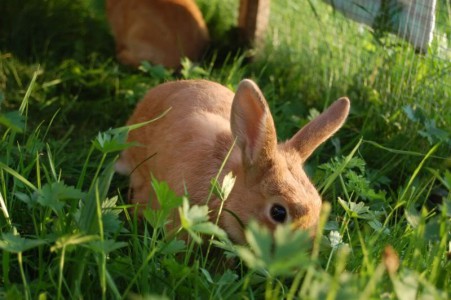
Often hay only consists of grasses and plant stalks, without herbs or any other plants. In their natural habitats, rabbits mainly eat the tips of leafs, nutrient rich parts of the plant or leaves, but not the lignified stalks. During the production of hay above 50% of the nutrients are already lost as leaves are crumbling of. Another 6-8% of the nutrients are lost with every month of storage. At best, fresh hay (stored for a maximum of 8 weeks) has already lost 62% of its nutrients (50% due to the loss of the leaves, 12% due to 2 months of storage).
Here a comparison of the nutrient composition of hay and grass (herbs are here not accounted for as the differences would be even more significant):
- on average grass contains 200mg ß-carotene and 200mg vitamin E
- on average hay contains 20mg ß-carotene and 30mg vitamin E
The biggest disadvantage of hay over grass, however, is: the water content. Whereas hay only has a minimal water content (less than 15%), meadow grass provides 80-90% water. The consequences of a diet low in water are diverse and unfortunately at times life shortening or even lead to early death (e.g. kidney failure).
Sources: ‚Vitamine in der Tierernaehrung‘, Working group for nutrients in animal nutrition; ‚Kaninchenfuetterung‘, Lackenbauer, Willi.
14. ‚Rabbits suffering from diarrhoea should be solely fed on a hay diet.‘
Everybody knows the recommendations when a person suffers from diarrhoea: drink loads! This is due to high losses of water. Similarly applies to the rabbit: if a rabbit is ill with diarrhoea, it suffers a loss of huge amounts of water that want to be compensated. However, hay contains only little water.
Dr. med. vet. Anja Ewringmann states in ‚Leitsymptome beim Kaninchen‘ (‚Leading symptoms in rabbits‘): ‚Therapeutically it is very important to correctly feed rabbits when they suffer from diarrhoea. […] A hay and water diet is not suitable to meet the needs of these animals.‘
Generally, at first it is essential to find out the cause of the diarrhoea and this is to be treated.
What’s more, diarrhoea occurs when yeasts, E. coli bacteria, coccidia and other components of the intestinal flora widely spread and overgrow the healthy intestinal flora. This is the case, when the rabbits‘ food doesn’t provide the correct components or when the animal is weakened. If on introduction of a new food item an animal develops diarrhoea, either stop giving this at all or reduce the amount.
Ideally, when a rabbit suffers from diarrhoea, only offer known food that you know the rabbit tolerates well and which is easy to digest! Hay doesn’t belong into the group of easily to digest food as its water content is too low. In case of diarrhoea, a rabbit should in any case obtain a diet with a high water content in order to compensate the loss of water through the diarrhoea. Other possible foods are:
- apple: its pectins thicken the intestinal contents and hence may stop the diarrhoea
- boiled carrots: on cooking only are oligogalacturonic acids released
- cranberries and blueberries: contain oligogalacturonic acids as well
- stromach and intestine friendly herbs: contain various beneficial active substances
- structure rich fresh foods (hay, (meadow) herbs, grasses, leafy vegetables): structure rich food supports the digestion
- bananas: protect the mucous membranes
- oats: give only in the acute case of diarrhoea and if it’s very watery. Oats are dense in energy, which is very important in this case!
Provided that these are foods that the rabbit knows and tolerates well! If a rabbit only knows hay and other dry food, there’s no choice and this type of dry food and hay has to be given.
Nutritional needs in cases of diarhoea in rabbits
15. ‚Pet rabbits are domesticated and hence not able to select any more.‘

The ability to select isn’t correlated to domestication; whether an animal is able to select isn’t inherited but rather learned and tested. Rabbits use their taste buds when taking a ‚taste bite‘ to evaluate whether a plant is poisonous. Supported is this sensation through their sense of smell. Thus rabbits learn primarily through sensory perception and experiences. These experiences are passed on from the adult rabbits to their baby rabbits, so that baby rabbits also learn from their parents. On the one hand through the taste of mother’s milk (this too contains the ‚correct plants‘), but on the other hand also through observation of adult rabbits when they are feeding. Not only is the selection of poisonous plants learnt this way, but also the choice and composition of forage crops. Rabbits very much rely on their taste indicating for example a too high protein content. The fact that rabbits select is surely known to all rabbit owners; for example prefer rabbits always carrots greens over carrots and the carrot green is consumed in far higher amounts. Similarly eat wild rabbits foremost herbs – roots (carrots are rootfruits) play a rather small role in their diet.
You’ll find more information about this topic here: Selection of poisonous plants
16. ‚A rabbit that doesn’t drink is ill.‘
In their natural habitat, rabbits cover their daily water needs through intake of fresh food; meadow plants contain ~80% water. Additionally they drink from puddles and small streams. Vegetables and fruits have high water contents too. If fed on a diet rich in fresh food, a rabbit may drink only very little or even nothing. This doesn’t mean it is ill; it just covers its water needs naturally this way. However, it is important to still always offer fresh water.
Whereas, if a rabbit from one day to the other doesn’t drink at all anymore, although the food isn’t richer in water than usual, it could be a sign of illness – equally, if all of a sudden extreme amounts are drunk.
17. ‚If a rabbit is fed ad libitum, food is more prone to rot.‘
Assuming that the food is checked twice a day (similarly to a rationised diet twice a day), no food item whatsoever will start to rot or ferment. Most vegetables will last for 2-3 days at least, fresh herbs for 24 hours.
18. ‚Rabbits start suffering from diarrhoea if fed too much fresh or green fodder.‘
In nature, rabbits usually feed on fresh food only, namely many different plants. Our pet rabbits have an almost idential gastrointestinal tract. If diarrhoea is caused from eating fresh food, it either doesn’t get the correct type of food, or the digestion or teeth don’t function as normal; or food is administered in the wrong way (sudden big portions, fermented food, etc.).
Dr. med vet Anja Ewringmann states in ‚Leitsymptome beim Kaninchen‘ (‚leading symptoms in rabbits‘)
‚Time and time again rabbit owners report that they don’t offer fresh food, as it may cause diarrhoea. However, in most cases this is due to a latent toothproblem. Obviously, less well chewed fruit and vegetables cause unusual fermentation more quickly than dried food components. In these rabbits periodic correcting of the teeth will support the re-establishment of a species typical diet.‘
19. ‚Industrial dry food is ideally adapted to the needs of a rabbit.‘
It should rather say: commercially mixed feed is ideally adapted to the requirements of the industry, as most commercially available rabbit food mixes don’t contain what our rabbits need, but rather what the industries produce as by products. And: customers even pay a lot of money for these products. For example, you very often find in the ingredient lists of industrially produced rabbit food ‚plant based by-products‘. These are less valuable waste-products from the production of another product, which are not declared in much detail. Hence, you’ll find a mixture of low quality (more like garbage) by products in the industrially produced dry foods of your pet shop. Naturally, rabbits would never eat anything like this, but the industry intensely flavours these foods so that every animal loves it. By the way: my cat really loves dry rabbit food. If you ask why my cat loves a complete plant based product that isn’t typical for a cat, we’re sure you can answer this question yourself… To enhance the not very appealing look of this questionable food, the industry even adds colourings. Yellow means grains, green herbs – at least that’s what is taught in the textbooks for food designers and indeed this seems to be the perception of the pet owners. He or she may think to do something good for their loved animal. In addition the mush is then enhanced with vitamins (as it is usually lacking any vitamins), unfortunately usually overdosed. At times vitamins are overdosed by as much as 10 times with 5 times as a rule. In excess vitamins can be harmful, something that is failed to mention . Secondary phytochemicals and other important substances are missing in these foods completely. Hence, the composition is far from being ideal.
20. ‚Dry food only guarantees an optimal supply of all nutrients!‘
Other foods contain essential nutrients equally; there is not one single nutrient that only exists in dry food. If this was the case, all wild rabbits would already have become ill or would have even died. On the contrary, many rabbits which are fed with mainly dry food suffer from deficiencies. The chart on the right shows, that prepared feed for rabbits isn’t adapted to the requirements of the species.
‚Only dry feed provides rabbits with all essential nutrients‘
Binding nutrient requirements for rabbits don’t exist. How much of each of the nutrients they need is controversial and every manufacturer refers to different guide values. These complete feedingstuffs are not specifically targeted for rabbits and their requirements:
Rabbits Guinea Pigs
Healthy Rabbit PRO from Albrecht
Constituents: Raw protein 12%, raw fat 2%, raw ash 8.5%, calcium 0.6%, phosphorus 0.4%.
Additives per kg
Vitamin A 20.000 I.E., Vitamin D 880 I.E., Vitamin E (alpha-tocopherolacetat) 150mg, copper (copper-II-sulphate, pentahydate) 15mg
Ingredients: Timothy grass, cocksfoot, hungarian brome, wheat straw flour, rapeseed flour, yellow pea, barley (whole plant), tomato pulp, treacle, chicoree powder, linseed, yeast (100% inactivated), dried rosemary, dried thyme, salt.
Ovator dwarf rabbit food
Complete food for dwarf rabbits
Constituents: cereals, products and by-products from the manufacture of fruits, dried herbage products and by-products from the manufacture of grains, oilseeds, minerals, products and by-products from sugar production, oils and fats. Healthy Guinea Pig PRO from Albrecht
Constituents: Raw protein 12%, raw fat 2%, raw ash 8.5%, calcium 0.6%, phosphorus 0.4%.
Additives per kg
Vitamin A 20.000 I.E., Vitamin D 880 I.E., Vitamin E (alpha-tocopherolacetat) 150mg, copper (copper-II-sulphate, pentahydate) 15mg
Ingredients: Timothy grass, cocksfoot, hungarian brome, wheat straw flour, rapeseed flour, yellow pea, barley (whole plant), tomato pulp, treacle, chicoree powder, linseed, yeast (100% inactivated), dried rosemary, dried thyme, salt.
Ovator guinea pig food
Complete food for guinea pigs
Constituents: cereals, products and by-products from the manufacture of fruits, dried herbage products and by-products from the manufacture of grains, oilseeds, minerals, products and by-products from sugar production, oils and fats.
Why should rabbits and guinea pigs have an identical nutritional requirement although they originate from totally different continents and even are completely different species?
21. ‚Dry food (like pellets) is necessary and important for dental abrasion‘
22. ‚Rabbits‘ teeth are worn down from hard food.‘
23. ‚Chewing of bread helps to wear down the teeth.‘
24. ‚Rough, long hay is important for wearing down teeth; hence, rabbits should eat a lot of hay.‘
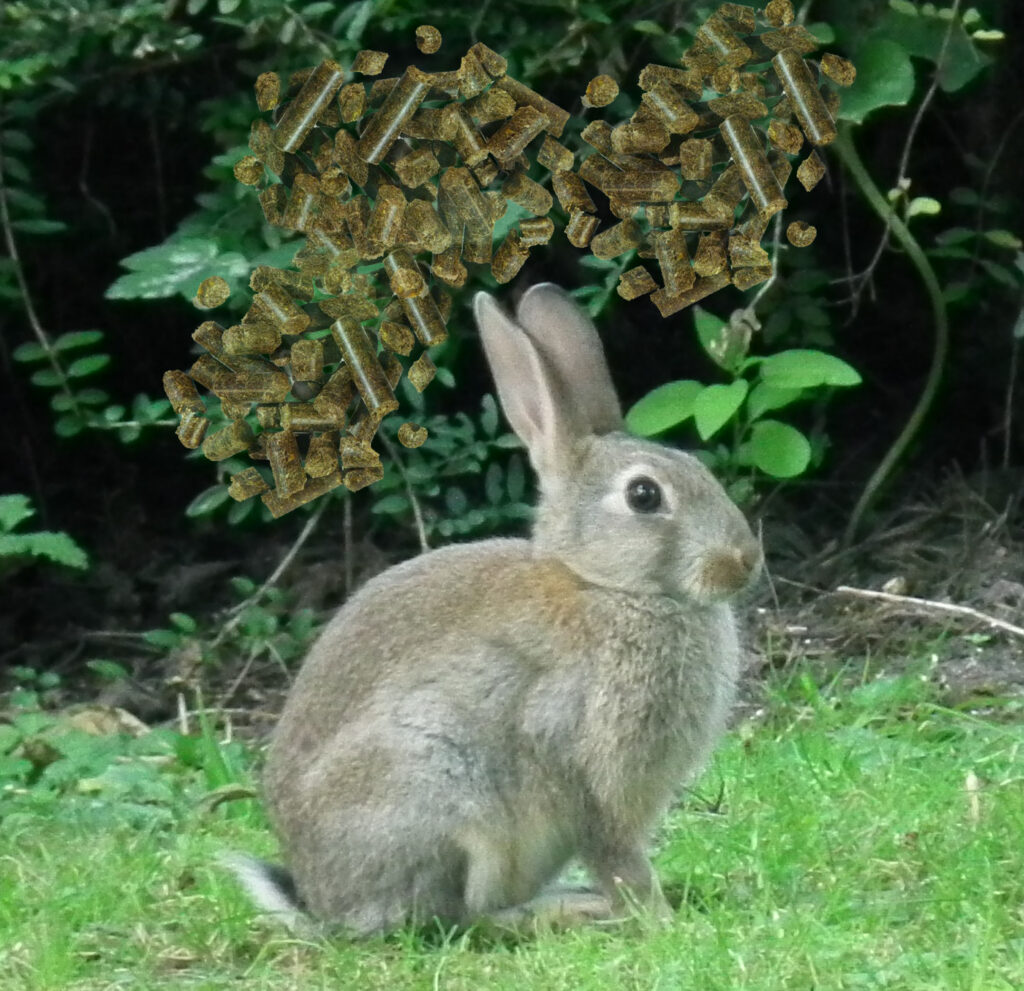
Here, I like to summarise 4 myths and would like to explain the basic principles of dental abrasion. First, the duration of chewing is mostly important for wearing down teeth. The longer a rabbits chews (teeth rubbing together), the better the teeth are worn. If food is particularly tasty and less filling, rabbits eat much more and consequently chew much longer (= the better the teeth wear down). Hence, a food that is not very filling and that tastes yummy, is best for the abrasion of the teeth.
Second, silica plays an important role. Silica is a constituent of all plants and ‚grinds‘ the teeth additionally. Hence, a rabbit’s diet is ideal if it isn’t very filling, it tastes great and is rich in silica. Dry food and bread fill up very quickly (less movement of the teeth) and therefore are less suitable for rabbits. The hardness of a food doesn’t have any effect on how the teeth are worn down. The following food is in particularly suitable for wearing down teeth: meadow herbs, grasses, kitchen herbs, dried herbs and leaves, hay and other vegetables…
How are the teeth worn down? Comprehensive information about the mechanisms of dental abrasion.
Graphic: Please, don’t give me bread or I get ill.
25. ‚Bulbous plants and potatoes are poisonous.‘
In order for a plant to be poisonous, it has to contain a substance that would lead to symptoms of poisoning. Neither boulbous plants nor potatoes contain such a substance. Where do these statements originate? Potatoes contain a lot of poorly digestible starches; this is why it is often not recommended to offer them as food, but they are not poisonous. Poisonous are merely the green parts of a potato and the potato plant itself, but not the fruit. In small amounts, these can even be offered.
Bulbous plants are usually quite spicy and hence are usually not at all or only in small amounts eaten. This is not due to a poisonous substance. The big problem is that pet owners often only distinguish between 2 groups of food: poisonous and not poisonous. This is why ‚indigestible‘ food and plants, even if tolerated in small amounts and not poisonous, are lumped together with poisonous food. It has to be stressed: the dose makes the poison! In excessive amounts every animal feed is poisonous, even water if consumed overdosed!
26. ‚Rabbits can’t select; if unlimited fresh food is available they’ll become obese.‘
Generally a diet with unlimited fresh food doesn’t make a rabbit overweight. Wild rabbits are surrounded day to day by vast amounts of food. However, a problem arises if rabbits are not kept correctly and their food doesn’t consist of the right components. Basically, the type of food needs to be matched with how the rabbit is kept, or at least this should be considered.
Grasses, hay and meadow herbs ad libitum will be suitable for every rabbit, even if living in a cage. Leafy vegetables are also competely unproblematic. Root vegetables can be offered limitless if leafy vegetables and meadow herbs are offered ad libitum, as rabbits will favour the leafy food. Seeds, cereal ears and similar should be fed only if necessary; and if they are given they should be rationalised. It is important to observe the rabbits (as with any other food). The offered choice of food can help to influence the energy content of a rabbits diet. But: most rabbits don’t need to be helped! If they don’t need the energy, they will automatically eat less energy rich food.
When such a diet could go wrong:
1. The rabbit isn’t properly fed ad libitum: only a few different type of foods or the wrong food is offered (e.g. commercial dry food, no leafy vegetables/meadow herbs ad libitum (the ultimate basic requirement!)
2. The rabbit lives in a confined space and may eat out of boredom; additionally it may be offered only a limited selection of food or the wrong type of food.
Around the clock, wild rabbits are surrounded by a rich supply of a huge variety of food. This doesn’t make them fat but rather healthy and lively!
27. ‚Grainfree food is a healthy replacement for mixed feed.‘
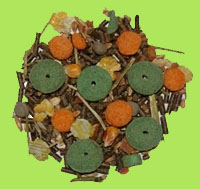
Over years rabbits have been fed with grain rich dry food as their basic diet; this has resulted in various digestive problems and other illnesses. This trend then started to develop away from grain rich food and at one point new dry feed came onto the market, advertised to be ‚grain free‘ or ‚without grain kernels‘. However, even grain free dry food is said to be problematic. Dry food stays dry food, even if it doesn’t contain any grains. It swells in the stomach and in the worst case scenario it rips the stomach walls, which only ends deadly (see swell experiments). Additionally, additives and the components of such a food are by itself dreadful. A dry food should generally only be used in cases of high energy requirements and only as supplementary food (and then in well calculated portions). It can be concluded that it should only be fed if necessary and then only in small portions. Never should pellets or other grinded and then pressed dry food be fed, as they result in the above mentioned effect of swelling. The structure of such a food has also been destroyed through the grinding process. Even if grain free, they result in the same damage as other dry food.
It is recommended to feed a mixture of seeds, dried herbs and maybe a little bit of dried vegetables if energy demands are high and only as a supplementary food.
Is dry food healthy?
Deficiencies in times of abundance: The secret of a rabbits diet which is appropriate to their needs.
28. ‚Cereals are poisonous for a rabbit.‘
Wild rabbits seasonally feed on grains, usually late summer, in autumn and winter when they eat the ears of the grains. This way, cereals are very well tolerated and offer a good supply of energy or supplement the rabbits‘ diet.
However, cereals are not tolerated in the following cases:
- If wheat of rye are fed. These varieties are hardly tolerated, rather choose other varieties that are tolerated better.
- If cereals become the main source of food. Cereals should always only be fed supplementary!
- If cereals are offered in the wrong form (grains). Always feed cereals with the husks (the complete ears of the grain or the grains with husks on)
- If it is highly processed (e.g. grinded for dry food, pressed, etc.) and hence, the structure got lost.
For examples it is possible to offer ears of grains saisonal (autumn) as long as the main part of the rabbit’s nutrition consists of meadow herbs, leafy vegetables, herbs and other species typical food.
29. ‚Salad, cucumber, etc. are inferior as they hardly contain any nutrients and only a lot of water.‘
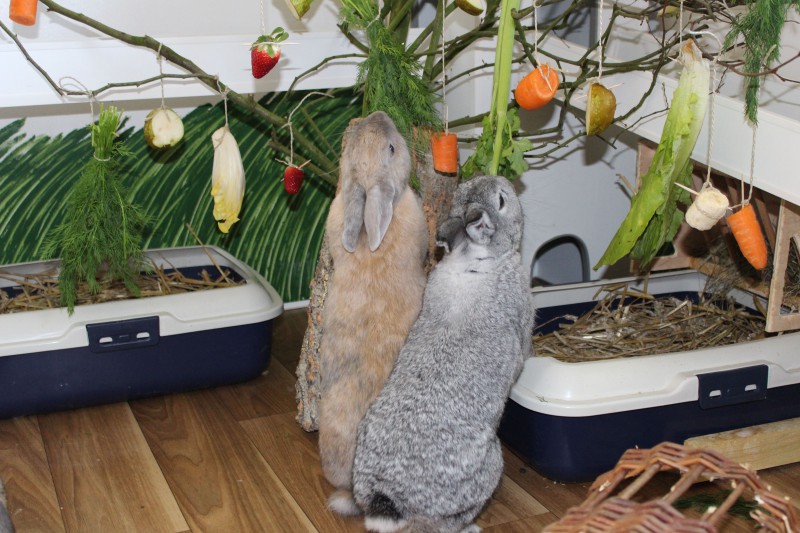
The water content of these vegetables is indeed high. Meadow plants (the natural basic nutrition of our rabbits) though, show similar water content levels. Our rabbit-pet nutrition is in most cases anyway far too low in water, especially because many dry foods (hay, dry feed…) as a main component of their diets are fed. This causes diverse diseases (kidney, bladder); that’s why feeding water rich food is in particularly important in a rabbit’s diet. It is not true that cucumber and lettuce have a low nutrient density . If you analyse the dry mass and nutrient composition they are similarly rich in nutrients as any other vegetables. Only if the high water content is considered in the calculation, the amount of nutrients is relatively low.
30. ‚Pellets consist of pressed herbs.‘
Often the recommendation is given to get rid of all the colourful components of a dry food and only to feed the healthy pellets or only to offer a food that solely contains pellets. These pellets supposedly consist of herbs and aren’t very unhealthy. These pellets, however, neither consist of herbs nor are they healthier than any of the other constituents of these ‚muesli‘ type foods. In most cases pellets are made from pressed components which are made green by using colourings. Ingredients for pellets are a variety of green flours, cereals, industry waste and flavourings which may lead to addiction etc. The green colour is artificial and misleads from the actual content.
31. ‚A rabbit’s diet should consist of 80% hay and 20% fresh food.‘
Similarly to the ‚100g rule‘ (myth 1), this recommendation is equally not advisable if you want to care for your rabbits as typically for their species as possible. Wild rabbits usually won’t find hay in the nature, so they feed almost 100% on fresh herbs and leaves. Our rabbits should be fed equally as their digestive system is still almost identically to the one of their wild relatives. Hence, they rely on such a fresh food diet. Fresh fodder should ideally sum up to as close to 100% as possible. If there are no possibilities to collect fresh food from meadows, these can be replaced with herbs, green and leafy vegetables as the main part of the nutrition complemented with other veg, fruit, hay and other feed.
According to feeding experiments of Schlolaut a rabbit is able – if fed on hay alone – to eat 58g of hay per kilogram bodyweight and day. This is equivalent to 87g for a 1.5kg rabbit.
Those 87g, according to the 80% hay rule, have to be 80% of the daily rations which implicates that the other 20% of the daily rations (which should be the allowed amount of fresh food according to various web pages) are only 17.4g.
This means: a 1.5kg rabbit is only allowed to get 17.4g of fresh food per day, if the rule of 80% hay and 20% fresh food is adhered to.
32. ‚Fruit and vegetables need to be washed with hot water.‘
Scientists have confirmed that it doesn’t make a difference whether fruit and vegetables are washed with hot or cold water; even if washed hot pesticides are not more likely to be washed off and furthermore vegetables may wilt and age quicker which reduces its shelf life. Additionally some of the essential vitamins may be destroyed through hot temperatures! Cold water and a brush or towel to dry is the better choice . Hot water is only necessary if fruit is waxed (e.g. apples with a glossy surface bought from a supermarket) as wax is more easily dissolved in hot water.
33. ‚It is recommended to peel fruit and vegetables when fed to rabbits.‘
Most of the vitamins are generally directly under the skin and if this is peeled off, the vitamins are peeled off too. Therefore it is not sensible to peel fresh food. The better choice it to wash it (see myth 32). However, organic food has to be the best choice as there’s no need to wash at all. Only very, very contaminated vegetables should be peeled as it would be more harmful if not.
34. ‚If caecum droppings are found, a rabbit is ill.‘
There are many reasons why caecum droppings may not be consumed (completely). Classically this happens when rabbits are getting used to meadow food in spring. The reason is simple: the rabbit obtains a diet with unusually high energy content. Once the rabbit is used to it again, these droppings also disappear again. Sometimes you’ll still find them occasionally. Even this is usually unproblematic as it may only indicate that the rabbit receives an energy rich diet. Rabbits only eat they caecum droppings completely if they don’t get enough energy, otherwise it is expected that some of it isn’t eaten. However, there are also other reasons why a rabbit may not eat their caecum droppings: e.g. if it smells differently (this may indicate coccidia; this is diagnosed by faecal samples) or if it tastes differently.
Many rabbits don’t eat their caecum droppings as they are fed with commercially produced food which is overdosed in its nutrient content. This may cause by the way detrimental health effects (as overdosed synthetic vitamins and minerals can cause consequential negative side effects) and hence should be gradually reduced to none.
More reasons why caecum droppings are found: Little droppings lore
Sources:
– Fekete, S: Ernährung der Kaninchen; in: Ernährung monogastrischer Nutztiere, Kapitel 4; Wiesemüller, W. und Leibetseder, J. (Hrsg.), Gustav Fischer Verlag; Jena, Stuttgart; 1993
– Boback, A. W.: Das Wildkaninchen. Wittenberg Lutherstadt: A. Ziemsen Verlag, 1970
36. ‚Apple pips are poisonous and should be removed before apples are fed to a rabbit.‘
Apple pips contain about 1mg sambunigrin per kilogram pips. Sambunigrin is a cyanogen glucoside, which are enzymatically converted into cyanide and fructose. : LD(50) experiments have shown that an amount of 3-4mg/kg result in the death of 50% of the rabbits. The example considered a 2kg rabbit: this has to eat 6-8mg of the cyanogen glycoside in order to be lethal. This equals the amount of 6-8kg of apple pips! How much does an apple pip weigh? How many pips got an apple? Hydrocyanic acid is also metabolised in the body, which further implicates that this amount has to be eaten within an hour. If it takes more than one hour for this amount, even a higher amount has to be eaten. 6-8kg of apple pips are already a very unrealistic amount, considering one pip doesn’t weigh a lot and the pips are even hidden in the apple. Even if it was possible to feed a rabbit on apple pips only, a rabbit wouldn’t be able to feed this much and they would survive. Apple pips in small amounts and as they’d be fed as part of a whole apple are completely harmless.
37. ‚Stone fruit twigs contain hydrocyanic acid and hence shouldn’t be fed.‘
Twigs from any stone fruit variety can be fed without problems. They don’t contain hydrocyanic acid or any cyanogen glycosides like Amygdalin, which may similarly result in hydrocyanic acid through an enzymatic reaction . Amygdalin is only part of the pips of stone fruits, but not contained in leaves or bark. ‚Which twigs can I feed my rabbit?‘
‚Cyanids are only contained in seeds of fruit. Consequently twigs of all stone fruit varieties can be fed to chinchillas, guinea pigs and rabbits, as long as they haven’t been treated with plant protection products.‘ Mrs Dr. Jacqueline Kupper, University of Zurich: Source: ZZA 4/203 S. 57
‚According to a persistent rumour that floats about in the internet, twigs from stone fruit trees supposedly contain hydrocyanic acid. As I had already fed many of my rodents with such twigs in the past, I investigated this subject thoroughly when preparing my two books about hamsters. Tree and plant nurseries were astonished as rabbits and other rodents enthusiatically chewed on their young trees and this without any signs of poisoning. Dr. Petra Wolf from the veterinary university of Hannover explained that during the years of 1995 and 1996 she had carried out a study which unfortunately hasn’t been published. In this study all native fruit and deciduous trees had been tested. Only poplar tree and willow contain hydrocyanic components, but only in very small amounts. Another study carried out by the university of Zurich concluded the same.‘ Judy Fox in ‚Chinchillas: Artgerecht halten, pflegen und zuechten.‘ 2003, S. 43
18. ‚The gastro intestinal tract of a rabbit isn’t similar to its wild relative, as our pet rabbits are domesticated.‘
The digestive tract of our pet rabbits is identical to that of the wild rabbits. Differences can only be found in size and length of the different segments: big breeds usually have a less pronounced chymocolon (the proximal part of the colon) than small breeds. This however doesn’t allow for the conclusion that the rabbit’s diets have to be different. If a polish rabbit is fed in the same way as a lop rabbit, then the general nutritional requirements can be transferred from the wild rabbit to the pet rabbit.
‚How does the digestion work?‘
39. ‚Fruit (e.g. apples) contain a lot of sugar and hence shouldn’t be fed more often than 2-3 times per week.‘
Compared to vegetables fruit has a slightly higher sugar content; 100g apple contains ~10g sugar. The same amount of carrots contains only about half as much sugar. Interestingly, hay contains as much sugar as a fresh apple and is still in most areas recommended to be the main part of the rabbit’s nutrition. However, why should hay be fed ad libitum and apples (although they contain roughly the same amount of sugar) only 2-3 times per week? And isn’t such a high sugar content (whether from hay or apple) unhealthy and unnatural for the rabbits? Dandelions, which are part of the rabbit’s natural diet, containt only 1/10 less sugar than a fresh apple. As apples aren’t solely fed to the rabbit but rather as part of a balanced mixture of a variety of food, the components will be well balanced. Naturally, fruit should only supplement a rabbit’s nutrition. As part of the daily supply of food, fruit can be provided though.
43. ‚Eating of twigs and chewing on wood or other hard objects wears off the teeth.‘
The toughness of a food hardly has any significance for the wear of the teeth (neither of the molars nor the incisors). Naturally, the incisors are worn down through the grinding movements of the lower jaw and not through gnawing twigs. This is why twigs don’t play a role for the wear of the incisors, however, they can still be offered as it keeps rabbits occupied and they also provide important secondary plant compounds.
What are the mechanisms of tooth attrition?
44. ‚Rabbits have a ’stuffed‘ stomach and ’stuffed‘ intestines.‘
The term ’stuffed‘ stomach sounds terrifying; often it is used in connection with the tale that rabbits have to keep stuffing food into their tummies for a full functioning digestion (rabbits supposedly don’t have peristalsis) or otherwise they would die. However, rabbits show peristalsis (muscle movement) although it is less pronounced than in humans, but it is certainly there! The word ’stuffed stomach‘ and ’stuffed intestines‘ only exists in the internet and was probably created by an imaginative person and successively spread through the world wide web. It is not found in any expert literature. As with any other animal (and human too), the residence time of food in the stomach and intestines is linked to the food intake. If a rabbit starves or doesn’t receive enough food, there will be less droppings and the digesta moves slower. This is not the only influencing factors on the digestion though. The activity of the rabbits also plays an important role: a very active rabbits shows also a faster digestion than a rabbit that is less active. Psychological impacts and the quality of food influence the speed of digestion too. The rabbit is here no excemption; our own digestion is influenced by the same factors.
Is the rabbit able to survive periods of starvation although there isn’t constantly food ’stuffed‘ into the digestive system? Yes, it indeed is. Rabbits fill their stomachs with caecum droppings when food is running out. The pylorus also regulates how much of the contents are allowed to leave the stomach. In general, a rabbit never eats constantly, 24/7. Often the rabbit rests for many hours – as many other animals do too – and this isn’t a problem at all as there isn’t a necessity to ’stuff‘ the stomach continuously. If the rabbit reallly starves it is able to keep its stomach full with caecum droppings for up to 3 days before it becomes critical. Of course, a rabbit should
always continuously be offered with food!
Sources inter alia.:
– Swirski, G.: Zur Frage üiber die Retention des festen Mageninhaltes beim hungernden Kaninchen. Pharmacological Institut of Professor S. 0. Tsehirwinsky in Jurjew (Dorpat). Springer Berlin/Heidelberg, 1898
– Nehring K., Lehrbuch der Tierernährung und Futtermittelkunde, Neumann Verlag,1959, 7. Edition
45. ‚I’m worried to poison my rabbits. That’s why I don’t feed any fresh herbaceous plants, but only hay and vegetables.‘
The fear of the unknown is as you know quite common. You can buy hay from a pet shop and hence it is assumed to be ’safe‘. Additionally this may have been fed already for years and years without any rabbit being poisoned. Fresh herbaceous plants are still not very well known in the rabbit’s diet. However, there are a few plants that you also find in hay which are poisonous. Hay is nothing else than a mixture of forage plants, thus meadow plants. The only difference is that herbage is fresh whereas hay is dried and stored for some time. Some plants loose their toxicity through the drying process or at least it is weakened, but it is likely that rabbits can equally be poisoned through hay than through herbage as hay isn’t as non toxic and safe as assumed. Since rabbits only poison themselves extremely rarely and often only if fed fundamentally wrong as they possess a very strong ability to select the correct food, cases of rabbit poisoning through feeding hay are similarly rare as cases of poisoning in general. Additionally it’s also usually the last thought that considers the hay to be the source of the poisoning.
The most poisonous plant in hay is without doubt the autumn crocus. Its toxicity is not even weakened through the drying process. From herbage rabbits are able to select relatively well, as its original smell and taste isn’t compromised yet whereas in hay autumn croci are often crumbled and odourless, as they only smell of hay. Hence they are less noticeable in taste which makes this plant to be more likely to be eaten by the rabbit.
Additionally hay may have been sprayed or fertilised, it could have grown next to a motorway, maybe it got into contact with poisonous substances either during storage or the drying process (e.g. motoroils in a barn), it could be contaminated with diseases (e.g. myxomatosis, RHD…) or it could contain mould spores due to incorrect storing conditions; all of these may have toxic effects. Vegetables too may not be as healthy as thought, as these are sprayed with various substances too during their growth in the field.
Commercially bought food can also contain toxic substances (at this point it may be worth recommending the book: ‚Katzen wuerden Maeuse kaufen‘ (cat’s would like to buy mice), which uncovers the manipulations of the feed industry). However, poisoning is extremely rare in rabbits that are fed a balanced diet athough they could equally get poisoned from hay as they could from herbage of vegetables. Reversely, fresh meadow plants are not any more dangerous than hay or vegetables of commercially produced rabbit food. A diet that offers a good choice of various food from which the rabbit can choose is the best prevention. Any potentially poisonous food then doesn’t have to be eaten – they can leave it aside and choose something else instead (ad libitum).
Plant identification for ‚picking‘ beginners
46. ‚Hay crumbles at the bottom of the bag are dangerous for rabbits.‘
Owners are cautioned to feed the crumbs from the bottom of a hay bag as they may cause digestive problems. These ‚crumbs‘ are usually from the more delicate parts of the plant, e.g. the leaves or from plants that are delicate and don’t have stalks in the first place. Wild rabbits would naturally select in particularly these plant parts and usually don’t eat the stalks (the ’normal‘ hay). Why should these dried parts of the plant lead to digestive problems? They don’t, as many, many rabbit owners will be able to confirm who feed dried herbs to their rabbits. They are not different to the rest of the hay. They may only pose a risk when the rabbit is very hungry and gobbles a lot of it in a short time. A rabbit that receives a healthy diet may like those crumbs, but may not be that starved that it gobbles them. The problem is usually not as much what they eat, but if they start to gobble, this can cause digestive problems. This is the reason why some rabbits don’t tolerate certain vegetables, herbage or hay ‚crumbs‘, etc. A rabbit that gobbles doesn’t chew very well and a big amount instead of many small amounts is eaten at once. This contradicts the natural way of feeding and hence also the digestive physiology.
47. ‚Chocolate is poisonous for a rabbit.‘
It’s not poisonous but rather unhealthy as its sugar content is very high. Sugar in high amounts can impair the digestion and cause digestive problems. The substance, which makes chocolate poisonous to other animals, like dogs and cats, is theobromin.
Why is it not poisonous for the rabbit?
LD 50 for rabbits: s.c. 1000mg/kg
Compared to mice (values for s.c. and oral): p.o. 837mg/kg, s.c. 530mg/kg. This suggests that rabbits tolerate theobromin very well and don’t die from relatively small doses (dog: p.o. 300mg/kg). Chocolate only contains very small amounts of Theobromin (0.6-10mg/g depending on the cocoa content of the chocolate) implicating that rabbits – even if they consumed larger amounts of chocolate – wouldn’t die of theobromin poisoning. Even if those amounts could be achieved even higher amounts of sugar would have been eaten by the rabbit. Therefore the rabbits would rather die of the extremely high sugar intake and it’s consequences than of the intake of theobromin. Hence, don’t feed chocolate to your rabbit! But not because it’s likely that you’d poison your rabbit but rather because it is unhealthy and it would damage its digestion.
48. ‚Root vegetable make rabbits fat and are extremely high in calories.‘
Root vegetables aren’t fatteners. Often it is advised not to feed rabbits carrots, beets or celeriac if the rabbits are overweight and as a dietary measure. This meassure is not appropriate as root vegetables are not richer in energy than their natural nutrition (meadow herbs). How rabbits can loose weight successfully, healthily and in a sensible way, you can find our here. Overweight rabbits
Graph: Calorie content of various herbage
celeriac, carrot, kohlrabi, parsnip, spinach, savoy abbage, parsley, dill, basil, dandilions
29. ‚(Root) vegetables are high in carbs (sugar, starch), which unbalance the intestinal flora! Hence, rabbits should be fed with hay and meadow herbs and not with larger amounts of vegetables.‘
Vegetables are relatively low in carbohydrates compared to the rabbits natural diet in its wild habitat. Hay isn’t low in carbs either.
Graph: Carbohydrate content of various fresh food
celeriac, carrot, kohlrabi, parsnip, spinach, savoy cabbage, parsly, dandilions
50. ‚Rabbits can select on domestic plants only as they don’t know any exotic plants.‘
This is one of the more creative myths. It it therefore often reasoned that rabbits should only get food from their domestic habitat and hay. It’s not clear how rabbits then ‚recognise‘ hay as this isn’t made by mother nature. The way rabbits select doesn’t mean they see a carrot or a dandilion and then this makes them think ‚Ah, this is a carrot, so I’m allowed to eat 86g of it‘. They don’t recognise the plant but rather use their taste, smell and sense of touch to examine the plant (sniffing, taste bite…) for the first time; on recurrent occasions the smell of the plant would help them to recognise it again.
Using their senses rabbits are able to assess their food, whereever its origin. Furthermore there are also wild rabbits in tropical regions which equally successful select the plant world in these latitudes. Rabbits have spread throughout the world; even in areas with completely different vegetation they have been able to select successfully. The principle of selection is not understood if reasoning like this continues. Further reading on this topic can be found here: Selection of food in rabbits
51. ‚There’s only one correct type of diet for rabbits. This has to be adhered to!‘
I’m quite fascinated that rules, norms and laws with regard to a rabbits diet are often adhered to without questioning; as they are published in the web in particular. In the past it was acclaimed: ‚Hay, hay and even more hay‘; these days however hay is evil and ‚ad libitum and nothing else‘ is postulated. Nutrition is complex and surely there are a few fundamentals that are scientifically proven and should create a foundation for the complete nutritional concept. Still, nutrition has various sides and is only then ‚ideal‘ when it fits the way a rabbit is kept and the way of life of its owner. Every animal and pet owner is unique and especially this influences the concept of a diet in various ways. One rabbit will rely on a diverse continous supply of food around the clock, another one may well live with 2 meals a day that provide 2 varieties of vegetables and a few other foods as well. One pet owner has got the chance to grow herbs (and is willing to) and the other not.
The main aspect of a rabbit’s nutrition is, to observe the rabbit and to adapt where necessary. Although carrots are usually very well tolerated, some animals may tolerate them less or not at all. For those a slightly different diet may be the ideal one. I really want to encourage everybody to observe their rabbit/rabbits and to try new ways through cautiously providing new food in order to establish what is ‚ideal‘ for your own rabbit(s) – disregard ideologies, what has been thought to be fundamentals and established views. I recommend: be critical but open minded to new information – including information from ‚kaninchenwiese‘ – and cumulate information from various sources.
52. ‚Wild rabbits mainly eat hay in winter and no fresh food.‘
It is often propagated that wild rabbits only eat ‚hay‘ or ‚meagre food‘ in winter. However, this is not entirely true. Most part of the winter (depending where and on the year) is snow free, i.e. rabbits have access 24/7 to fresh food which they nibble on. If there’s snow, they dig and scratch for any fresh food unterneath the snow. Ideal this is not,
and many more rabbits die in winter than in summer. Obviously we strive for an optimal nutrition of our rabbits throughout the year.
Whoever owns free range rabbits with access to nature and its winterly diversity, knows that they behave similarly to their wild relatives in winter. They dig innumerable amounts of holes in the snow and eat the emerging meadow underneath.
Furthermore they dig out sloes, acorns and other fruits, which have been left over from autumn and buried underneath the snow. They ‚peel‘ bark from the trees and nibble the autumn leaves – as do their wild rabbit relatives. Although most of the meadow plants in winter are brown, on a closer look there are quite a few fresh, green plants, like ribwort, dandilions, various grasses…
All the digging obviously consumes a lot of energy and this is why many wild rabbits loose weight in winter. If the winter is very harsh and snow covers the ground for too long, unfortunately many rabbits still die from exhaustion, lack of food and diseases. Especially in winter the mortality rate in nature is very high. This is also important as this ensures that only the strongest animal survive (in order to reproduce in spring again survival of the fittest!).
This effect, however, is not wanted when keeping pets.
Ideally, all our rabbits are optimal cared for and none should be weakend. Natural selection in times of need is not necessary. Consequently our rabbits are fed with a broad range of healthy foods in winter too.
Besides, wild rabbits even don’t eat hay in winter. If you know any rabbits in your environment, why not put some hay out and see what happens? Usually they ignore the hay as the meagre food that rabbits still find in winter (plant remains from underneath the snow, roots, bark…) is still richer in nutrients than hay. Hay is not a natural food in the wild rabbits habitat; they still find fresh herbaceous and other plants, barks, …
53. ‚Don’t pick from meadows that are known to be frequented by dogs (transmission of diseases through dog poo).‘
Many warnings can be found online, not to pick from meadows where dogs are taken for a walk and hence leave their poos. These meadows, however, are relatively harmless in comparison to meadows where wild rabbits live. Most diseases are host-specific and usually only affect the same species (this being a dog or a rabbit), whereas other animals don’t get infected or only very rarely. A meadow, on which wild rabbits (or sick pet rabbits) live, entails the real risk that pathogens are carried over from the fresh grass. This explains the importance to gather knowledge about vaccinations before picking from meadows or other areas outside your home. It is also advisable to test samples of droppings for coccidia and worms before vaccinating your rabbit.
Dog poo is relatively harmless as long as distance is kept to avoid picking contaminated food.
54. ‚Only rabbits that are kept outside – if at all, may have to put on some weight in winter. If rabbits are kept indoors this weight gain should be counteracted!‘
Even rabbits that are kept indoors usually show weight changes over the year. These variations in weight are quite natural and certainly not harmful. Even indoor rabbits are allowed to put on some weight as long as they loose it again in spring (April – Mai). Alarming is such a weight gain only if this is all year round.
55. ‚Dry food shouldn’t be offered at the same time with fresh food as this can lead to digestive problem.‘
Often I came across the recommendation that dry food should be fed staggered to fresh food. This advice may have resulted from the observation that a few types of food don’t go well with fresh food. However, intolerances usually only occur when the digestion has already suffered from dry food, if fresh food if introduced too quickly or if tooth tips have developped (usually as a result of dry food too).
Dry food can therefore indeed lead to intolerances of fresh food (tooth tips, an already irritated digestion). However, this can’t entirely be avoided by giving the 2 types of food at different times. It is in fact more important, to introduce fresh food slowly and if intolerances occur to reduce the amount or to investigate droppings or teeth for other causes. If dry food is extremely poorly tolerated it can be instantly replaced with seeds. These (and other dry foods, like dried herbs) are tolerated very well with fresh food.
56. ‚Rabbits that haven’t been kept well, that have been kept indoors or that didn’t grow up with meadow food are not able to select.‘
For rabbits with these histories this is generally not true, however it is advisable to introduce new fresh food slowly to enable them to select. It is further more important to keep them species typical. When they are slowly introduced to a species typical diet containing a varied selection of fresh plants and if they are kept in a rabbit friendly environment, then they are also able to select within a short period of time. Selection behaviour
57. ‚Silage is an unsuitable food for rabbits and may even be harmful.‘
In many older books, silage is presented as a standard type of food that was based on experiences. Even these days, many rabbit owners, who offer silage food, have made positive experiences. It has to be advised though, that silage may contain defects (wrong manufacturing practices and/or storage). If this is the case, intolerances may be caused.
58. ‚Variances in weight indicate illnesses. Through regular meassurements of the rabbits‘ weight illnesses can be identified timely.‘
Seasonal weight changes are generally natural and not a sign for illnesses (e.g. weight gain in winter). Still it may be helpul to weigh the rabbit regularly as especially large weight losses, which don’t relate to seasonal variations, may indicate a disease.
59. ‚Artificial vitamins are harmless and play an important role in the nutrition of a rabbit.‘
Species appropriate feeding can’t be replaced with a dry food that has been enriched with vitamins as there are more than 100 other important nutrients that are important for the health and wellbeing of the rabbit and which have to be taken in through the rabbit’s food. Consequently, a diet appropriate to the species is, indepent from any added vitamins, indispensable.
Conversely, if rabbits are fed appropriate to their species, artificial vitamins are superfluous. Assuming a rabbit isn’t fed according to their requirments it may be justifiable to say that added artificial vitamins are ‚better than nothing‘, but I don’t recommend such a diet.
Benefits of satisfying the needs for vitamins naturally in comparison to artifical vitamins:
- artificial and natural vitamins are chemically not identical, e.g.:
Natural vitamin E: RRR--tocopherol = d--tocopherol
Articial vitamin E: all rac --tocopherol = d,l--tocopherol
- Vitamins are utilised to the best effect if they are taken in from the plant with all its other natural components and substances. The effect is then rather more positive on the health than from the intake of artificial vitamins.
- The substances which we take in as artificial vitamins usually don’t exist in exactly the same form in nature. You may still remember your chemistry lessons: a substance can have completely different effects if on its own compared to it being mixed with other substances. E.g. uranium is naturally found in water and rocks (in this form harmless); however, if ‚extracted‘ from this natural source and used in this pure form, a direct contact with this substance should be avoided.
- Biological availability and resorbtion of natural vitamins is higher than of artificial vitamins.
- Vitamins in their natural form (e.g. as part of plants) are not harmful and are very difficult to overdose; however, if these substances are applied in their pure form (not as part of their natural origin: the plant), for example as an artificial vitamin, overdosing is more likely to happen and may be harmful.
- Other plant constituents boost the effect of natural vitamins; however these are missing in artificial vitamins. As an example: bioflavonoids boost the effect of vitamin C by 4 times.
- The risk of allergies and other side effects is smaller


